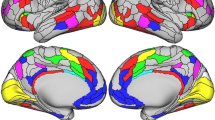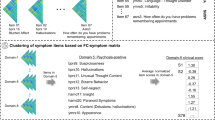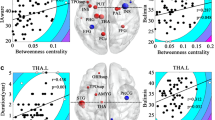Abstract
Clinical assessments often fail to discriminate between unipolar and bipolar depression and identify individuals who will develop future (hypo)manic episodes. To address this challenge, we developed a brain-based graph-theoretical predictive model (GPM) to prospectively map symptoms of anhedonia, impulsivity, and (hypo)mania. Individuals seeking treatment for mood disorders (n = 80) underwent an fMRI scan, including (i) resting-state and (ii) a reinforcement-learning (RL) task. Symptoms were assessed at baseline as well as at 3- and 6-month follow-ups. A whole-brain functional connectome was computed for each fMRI task, and the GPM was applied for symptom prediction using cross-validation. Prediction performance was evaluated by comparing the GPM to a corresponding null model. In addition, the GPM was compared to the connectome-based predictive modeling (CPM). Cross-sectionally, the GPM predicted anhedonia from the global efficiency (a graph theory metric that quantifies information transfer across the connectome) during the RL task, and impulsivity from the centrality (a metric that captures the importance of a region) of the left anterior cingulate cortex during resting-state. At 6-month follow-up, the GPM predicted (hypo)manic symptoms from the local efficiency of the left nucleus accumbens during the RL task and anhedonia from the centrality of the left caudate during resting-state. Notably, the GPM outperformed the CPM, and GPM derived from individuals with unipolar disorders predicted anhedonia and impulsivity symptoms for individuals with bipolar disorders. Importantly, the generalizability of cross-sectional models was demonstrated in an external validation sample. Taken together, across DSM mood diagnoses, efficiency and centrality of the reward circuit predicted symptoms of anhedonia, impulsivity, and (hypo)mania, cross-sectionally and prospectively. The GPM is an innovative modeling approach that may ultimately inform clinical prediction at the individual level.
This is a preview of subscription content, access via your institution
Access options
Subscribe to this journal
Receive 13 print issues and online access
$259.00 per year
only $19.92 per issue
Buy this article
- Purchase on Springer Link
- Instant access to full article PDF
Prices may be subject to local taxes which are calculated during checkout




Similar content being viewed by others
Data availability
Datasets will be shared on reasonable request to the corresponding author.
Code availability
The Brain Connectivity Toolbox was used for graph theoretical analyses and is freely available at https://sites.google.com/site/bctnet. The following functions were used: weight_conversion.m, clustering_coef_wu.m, efficiency_wei.m, distance_wei.m, charpath.m, betweenness_wei.m. Connectome-based predictive modeling (CPM) was done using MATLAB scripts available by Shen and colleagues [47].
References
Hirschfeld RMA, Lewis L, Vornik LA. Perceptions and impact of bipolar disorder: How far have we really come? Results of the National Depressive and Manic-Depressive Association 2000 Survey of individuals with bipolar disorder. J Clin Psychiatry. 2003;64:161–74.
Ghaemi SN, Boiman EE, Goodwin FK. Diagnosing bipolar disorder and the effect of antidepressants: A naturalistic study. J Clin Psychiatry. 2000;61:804–8.
Angst J, Cui L, Swendsen J, Rothen S, Cravchik A, Kessler RC, et al. Major depressive disorder with subthreshold bipolarity in the national comorbidity survey replication. Am J Psychiatry. 2010;167:1194–201.
Sharma V, Khan M, Smith A. A closer look at treatment resistant depression: Is it due to a bipolar diathesis? J Affect Disord. 2005;84:251–7.
De Almeida JRC, Phillips ML. Distinguishing between unipolar depression and bipolar depression: Current and future clinical and neuroimaging perspectives. Biol Psychiatry. 2013;73:111–8.
Scheinost D, Noble S, Horien C, Greene AS, Lake EM, Salehi M, et al. Ten simple rules for predictive modeling of individual differences in neuroimaging. Neuroimage. 2019;193:35–45.
Siddiqi SH, Taylor SF, Cooke D, Pascual-Leone A, George MS, Fox MD. Distinct symptom-specific treatment targets for circuit-based neuromodulation. Am J Psychiatry. 2020;177:435–46.
Scheinost D, Hsu TW, Avery EW, Hampson M, Constable RT, Chun MM, et al. Connectome-based neurofeedback: A pilot study to improve sustained attention. Neuroimage. 2020;212:116684.
Finn ES, Shen X, Scheinost D, Rosenberg MD, Huang J, Chun MM, et al. Functional connectome fingerprinting: Identifying individuals using patterns of brain connectivity. Nat Neurosci. 2015;18:1664–71.
Beaty RE, Kenett YN, Christensen AP, Rosenberg MD, Benedek M, Chen Q, et al. Robust prediction of individual creative ability from brain functional connectivity. Proc Natl Acad Sci USA. 2018;115:1087–92.
Chen J, Tam A, Kebets V, Orban C, Ooi LQR, Asplund CL, et al. Shared and unique brain network features predict cognitive, personality, and mental health scores in the ABCD study. Nat Commun. 2022;13:1–17.
Greene AS, Gao S, Scheinost D, Constable RT. Task-induced brain state manipulation improves prediction of individual traits. Nat Commun. 2018;9:1–13.
Horien C, Floris DL, Greene AS, Noble S, Rolison M, Tejavibulya L, et al. Functional connectome–based predictive modeling in autism. Biol Psychiatry. 2022;92:626–42.
Ibrahim K, Noble S, He G, Lacadie C, Crowley MJ, McCarthy G, et al. Large-scale functional brain networks of maladaptive childhood aggression identified by connectome-based predictive modeling. Mol Psychiatry. 2022;27:985–99.
Yip SW, Scheinost D, Potenza MN, Carroll KM. Connectome-based prediction of cocaine abstinence. Am J Psychiatry. 2019;176:156–64.
Medaglia JD, Lynall ME, Bassett DS. Cognitive network neuroscience. J Cogn Neurosci. 2015;27:1471–91.
Dong D, Li C, Ming Q, Zhong X, Zhang X, Sun X, et al. Topologically state-independent and dependent functional connectivity patterns in current and remitted depression. J Affect Disord. 2019;250:178–85.
He H, Yu Q, Du Y, Vergara V, Victor TA, Drevets WC, et al. Resting-state functional network connectivity in prefrontal regions differs between unmedicated patients with bipolar and major depressive disorders. J Affect Disord. 2016;190:483–93.
Jacob Y, Morris LS, Huang KH, Schneider M, Rutter S, Verma G, et al. Neural correlates of rumination in major depressive disorder: A brain network analysis. NeuroImage Clin. 2020;25:102142.
Kim K, Kim SW, Myung W, Han CE, Fava M, Mischoulon D, et al. Reduced orbitofrontal-thalamic functional connectivity related to suicidal ideation in patients with major depressive disorder. Sci Rep. 2017;7:15772.
Sheng J, Shen Y, Qin Y, Zhang L, Jiang B, Li Y, et al. Spatiotemporal, metabolic, and therapeutic characterization of altered functional connectivity in major depressive disorder. Hum Brain Mapp. 2018;39:1957–71.
Gong L, Hou Z, Wang Z, He C, Yin Y, Yuan Y, et al. Disrupted topology of hippocampal connectivity is associated with short-term antidepressant response in major depressive disorder. J Affect Disord. 2018;225:539–44.
Spielberg JM, Sadeh N, Cha J, Matyi MA, Anand A. Affect regulation–related emergent brain network properties differentiate depressed bipolar disorder from major depression and track risk for bipolar disorder. Biol Psychiatry Cogn Neurosci Neuroimaging. 2022;7:765–73.
Manelis A, Almeida JRC, Stiffler R, Lockovich JC, Aslam HA, Phillips ML. Anticipation-related brain connectivity in bipolar and unipolar depression: A graph theory approach. Brain. 2016;139:2554–66.
Rubinov M, Sporns O. Complex network measures of brain connectivity: Uses and interpretations. Neuroimage. 2010;52:1059–69.
Insel T, Cuthbert B, Garvey M, Heinssen R, Pine DS, Quinn K, et al. Research Domain Criteria (RDoC): Toward a new classification framework for research on mental disorders. Am J Psychiatry. 2010;167:748–51.
Greene AS, Gao S, Scheinost D, Constable RT. Task-induced brain state manipulation improves prediction of individual traits. Nat Commun. 2018;9:2807.
Pizzagalli DA, Jahn AL, O’Shea JP. Toward an objective characterization of an anhedonic phenotype: A signal-detection approach. Biol Psychiatry. 2005;57:319–27.
Whitton AE, Kumar P, Treadway MT, Rutherford AV, Ironside ML, Foti D, et al. Mapping disease course across the mood disorder spectrum through a research domain criteria framework. Biol Psychiatry Cogn Neurosci Neuroimaging. 2021;6:706–15.
First M, Spitzer R, Gibbon M, Williams J Structured Clinical Interview for DSM IV-TR Axis I Disorders, Research Version, Patient Edition (SCID-I/P). New York: New York State Psychiatric Institute; (2002).
Pessiglione M, Seymour B, Flandin G, Dolan RJ, Frith CD. Dopamine-dependent prediction errors underpin reward-seeking behaviour in humans. Nature. 2006;442:1042–5.
Whitton AE, Kumar P, Treadway MT, Rutherford A, Ironside ML, Foti D, et al. Distinct profiles of anhedonia and reward processing and their prospective associations with quality of life among individuals with mood disorders. Mol Psychiatry. https://doi.org/10.1038/s41380-023-02165-1 (2023).
Watson D, Weber K, Assenheimer JS, Clark LA, Strauss ME, McCormick RA. Testing a tripartite model: I. Evaluating the convergent and discriminant validity of anxiety and depression symptom scales. J Abnorm Psychol. 1995;104:3–14.
Patton JH, Stanford MS, Barratt ES. Factor structure of the barratt impulsiveness scale. J Clin Psychol. 1995;51:768–74.
Gonzalez JM, Bowden CL, Katz MM, Thompson P, Singh V, Prihoda TJ, et al. Development of the bipolar inventory of symptoms scale: Concurrent validity, discriminant validity and retest reliability. Int J Methods Psychiatr Res. 2008;17:198–209.
Esteban O, Markiewicz CJ, Blair RW, Moodie CA, Isik AI, Erramuzpe A, et al. fMRIPrep: a robust preprocessing pipeline for functional MRI. Nat Methods. 2019;16:111–6.
Whitfield-Gabrieli S, Nieto-Castanon A. Conn: a functional connectivity toolbox for correlated and anticorrelated brain networks. Brain Connect. 2012;2:125–41.
Schaefer A, Kong R, Gordon EM, Laumann TO, Zuo XN, Holmes AJ, et al. Local-global parcellation of the human cerebral cortex from intrinsic functional connectivity mri. Cereb Cortex. 2018;28:3095–114.
Desikan RS, Ségonne F, Fischl B, Quinn BT, Dickerson BC, Blacker D, et al. An automated labeling system for subdividing the human cerebral cortex on MRI scans into gyral based regions of interest. Neuroimage. 2006;31:968–80.
Sackeim HA. The definition and meaning of treatment-resistant depression. J Clin Psychiatry. 2001;62:10–17.
Bouckaert RR, Frank E. Evaluating the replicability of significance tests for comparing learning algorithms. Pacific-Asia conference on knowledge discovery and data mining. Berlin, Heidelberg: Springer Berlin Heidelberg. (2004).
Zou H, Hastie T. Regularization and variable selection via the elastic net. J R Stat Soc Ser B Stat Methodol. 2005;67:301–20.
Qian J, Hastie T, Friedman J, Tibshirani R, Simon N. Glmnet for Matlab. http://hastie.su.domains/glmnet_matlab/ (2013).
Belleau EL, Bolton TAW, Kaiser RH, Clegg R, Cárdenas E, Goer F, et al. Resting state brain dynamics: Associations with childhood sexual abuse and major depressive disorder. NeuroImage Clin. 2022;36:103164.
Liu Y, Admon R, Mellem MS, Belleau EL, Kaiser RH, Clegg R, et al. Machine learning identifies large-scale reward-related activity modulated by dopaminergic enhancement in major depression. Biol Psychiatry Cogn Neurosci Neuroimaging. 2020;5:163–72.
Knutson B, Westdorp A, Kaiser E, Hommer D. FMRI visualization of brain activity during a monetary incentive delay task. Neuroimage. 2000;12:20–27.
Shen X, Finn ES, Scheinost D, Rosenberg MD, Chun MM, Papademetris X, et al. Using connectome-based predictive modeling to predict individual behavior from brain connectivity. Nat Protoc. 2017;12:506–18.
Pizzagalli DA. Toward a better understanding of the mechanisms and pathophysiology of Anhedonia: Are we ready for translation? Am J Psychiatry. 2022;179:458–69.
Sporns O. Graph theory methods: Applications in brain networks. Dialogues Clin Neurosci. 2018;20:111–20.
Yang H, Chen X, Chen ZB, Li L, Li XY, Castellanos FX, et al. Disrupted intrinsic functional brain topology in patients with major depressive disorder. Mol Psychiatry. 2021;26:7363–71.
Borgatti SP, Everett MG. A Graph-theoretic perspective on centrality. Soc Networks. 2006;28:466–84.
Pan PM, Sato JR, Paillère Martinot ML, Martinot JL, Artiges E, Penttilä J, et al. Longitudinal trajectory of the link between Ventral Striatum and depression in adolescence. Am J Psychiatry. 2022;179:470–81.
Moeller FG, Barratt ES, Dougherty DM, Schmitz JM, Swann AC. Psychiatric aspects of impulsivity. Am J Psychiatry. 2001;158:1783–93.
Castellanos-Ryan N, Séguin JR. Prefrontal and anterior cingulate cortex mechanisms of impulsivity. Oxford Handbook. Externalizing Spectr. Disord., Oxford University Press; (2015).
McDonald V, Hauner KK, Chau A, Krueger F, Grafman J. Networks underlying trait impulsivity: Evidence from voxel-based lesion-symptom mapping. Hum Brain Mapp. 2017;38:656–65.
Golchert J, Smallwood J, Jefferies E, Liem F, Huntenburg JM, Falkiewicz M, et al. In need of constraint: Understanding the role of the cingulate cortex in the impulsive mind. Neuroimage. 2017;146:804–13.
Kaasinen V, Honkanen EA, Lindholm K, Jaakkola E, Majuri J, Parkkola R, et al. Serotonergic and dopaminergic control of impulsivity in gambling disorder. Addict Biol. 2023;28:28.
Cohen-Gilbert JE, Sneider JT, Crowley DJ, Rosso IM, Jensen JE, Silveri MM. Impact of family history of alcoholism on glutamine/glutamate ratio in anterior cingulate cortex in substance-naïve adolescents. Dev Cogn Neurosci. 2015;16:147–54.
Okun MS, Mann G, Foote KD, Shapira NA, Bowers D, Springer U, et al. Deep brain stimulation in the internal capsule and nucleus accumbens region: Responses observed during active and sham programming. J Neurol Neurosurg Psychiatry. 2007;78:310–4.
De Koning PP, Figee M, Van Den Munckhof P, Schuurman PR, Denys D. Current status of deep brain stimulation for obsessive-compulsive disorder: A clinical review of different targets. Curr Psychiatry Rep. 2011;13:274–82.
Kim Y, McGee S, Czeczor JK, Walker AJ, Kale RP, Kouzani AZ, et al. Nucleus accumbens deep-brain stimulation efficacy in ACTH-pretreated rats: Alterations in mitochondrial function relate to antidepressant-like effects. Transl Psychiatry. 2016;6:e842.
Damme KS, Young CB, Nusslock R. Elevated nucleus accumbens structural connectivity associated with proneness to hypomania: A reward hypersensitivity perspective. Soc Cogn Affect Neurosci. 2017;12:928–36.
Whittaker JR, Foley SF, Ackling E, Murphy K, Caseras X. The functional connectivity between the nucleus accumbens and the ventromedial prefrontal cortex as an endophenotype for bipolar disorder. Biol Psychiatry. 2018;84:803–9.
Russo SJ, Nestler EJ. The brain reward circuitry in mood disorders. Nat Rev Neurosci. 2013;14:609–25.
Kelley ME, Choi KS, Rajendra JK, Craighead WE, Rakofsky JJ, Dunlop BW, et al. Establishing evidence for clinical utility of a neuroimaging biomarker in major depressive disorder: prospective testing and implementation challenges. Biol Psychiatry. 2021;90:236–42.
Elliott ML, Knodt AR, Cooke M, Kim MJ, Melzer TR, Keenan R, et al. General functional connectivity: Shared features of resting-state and task fMRI drive reliable and heritable individual differences in functional brain networks. Neuroimage. 2019;189:516–32.
McIntyre RS, Berk M, Brietzke E, Goldstein BI, López-Jaramillo C, Kessing LV, et al. Bipolar disorders. Lancet. 2020;396:1841–56.
Funding
The study was supported by the National Institute of Mental Health (NIMH) (Grant Nos. R01 MH101521 and R37 MH068376 to DAP). RD is an Awardee of the Weizmann Institute of Science – Israel National Postdoctoral Award Program for Advancing Women in Science. AEW was supported by a National Health and Medical Research Council Investigator Grant (GNT 2017521). Biostatistical consultation was provided by Harvard Catalyst.
Author information
Authors and Affiliations
Contributions
RD: Conceptualization; Data curation; Formal analysis; Investigation; Methodology; Resources; Software; Visualization; Writing - Original draft; Writing – Review & Editing. AEW: Conceptualization; Investigation; Project administration; Methodology; Resources; Writing – Review & Editing. MTT: Investigation; Project administration; Resources; Writing – Review & Editing. AVR: Investigation; Project administration; Resources; Writing – Review & Editing. PK: Investigation; Project administration; Resources; Writing – Review & Editing. MLI: Investigation; Project administration; Resources; Writing – Review & Editing. RHK: Investigation; Project administration; Resources; Writing – Review & Editing. BR: Methodology; Writing – Review & Editing. DAP: Conceptualization; Funding acquisition; Methodology; Resources; Supervision; Writing – Review & Editing.
Corresponding author
Ethics declarations
Competing interests
Over the past 3 years, Dr. Pizzagalli has received consulting fees from Boehringer Ingelheim, Compass Pathways, Engrail Therapeutics, Neumora Therapeutics (formerly BlackThorn Therapeutics), Neurocrine Biosciences, Neuroscience Software, Otsuka, Sage Therapeutics, Sama Therapeutics, Sunovion, and Takeda; he has received honoraria from the American Psychological Association, Psychonomic Society and Springer (for editorial work) and from Alkermes; he has received research funding from the Bird Foundation, Brain and Behavior Research Foundation, Dana Foundation, Wellcome Leap, Millennium Pharmaceuticals, and NIMH; he has received stock options from Compass Pathways, Engrail Therapeutics, Neumora Therapeutics, and Neuroscience Software; he has a financial interest in Neumora Therapeutics, which has licensed the copyright to the human version of the probabilistic reward task through Harvard University. No funding from these entities was used to support the current work, and all views expressed are solely those of the authors. All other authors have no conflicts of interest or relevant disclosures.
Additional information
Publisher’s note Springer Nature remains neutral with regard to jurisdictional claims in published maps and institutional affiliations.
Supplementary information
Rights and permissions
Springer Nature or its licensor (e.g. a society or other partner) holds exclusive rights to this article under a publishing agreement with the author(s) or other rightsholder(s); author self-archiving of the accepted manuscript version of this article is solely governed by the terms of such publishing agreement and applicable law.
About this article
Cite this article
Dan, R., Whitton, A.E., Treadway, M.T. et al. Brain-based graph-theoretical predictive modeling to map the trajectory of anhedonia, impulsivity, and hypomania from the human functional connectome. Neuropsychopharmacol. (2024). https://doi.org/10.1038/s41386-024-01842-1
Received:
Revised:
Accepted:
Published:
DOI: https://doi.org/10.1038/s41386-024-01842-1



